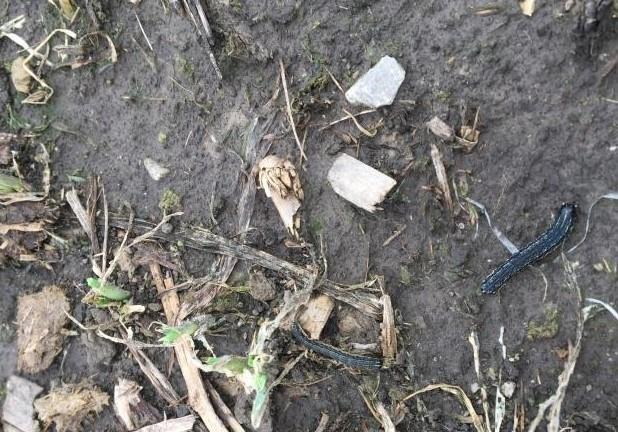Fall armyworm – note Y on face and four raised bumps in the shape of a square near the end of the abdomen.
Larvae have a wide host range of at least 80 plants, but prefer grasses (corn, sorghum, bermudagrass, tall fescue). They can also feed on alfalfa, barley, oats, ryegrass, vegetables and soybean. Armyworms tend to move quickly into new areas in large numbers. Injury caused by feeding is mainly defoliation, sometimes leaving main stems behind. Older larvae can cause extensive injury, especially to young plants, and can destroy the growing point. Injury is ragged and looks like hail damage. Fall-seeded grasses can be severely impacted; larval feeding can cause plant stunting or death.

Fall armyworms and defoliation of a cover crop.
Scouting for fall armyworm should occur during the early morning or late in the day, since this is when larvae are most active. Start in the most valuable crops first. The best way to confirm the presence of fall armyworm in pastures or hayfields is to use a sweep net. The net will pick up larvae that are too small to find other ways. If you find fall armyworm larvae in the sweep net, determine how many caterpillars are present per square foot by looking on plants and in the litter on the soil. If you don’t have a sweep net, check areas that look dead, wilting or drought-stressed, or where birds are congregating. Sometimes, you can find the frass (insect excrement), which are green pellets. The generic threshold is 2 or 3 caterpillars per square foot.
Management is based on the intended use of the crop/pasture. If the threshold is met or exceeded, consider cutting the field; baling the hay quickly will ensure the caterpillars won’t continue to feed. If the plants are used as ground cover, it may not be necessary (or profitable) to spray a foliar insecticide. However, if an application is warranted, timing is critical for effective larval suppression. Insecticide applications for control of fall armyworm larvae are most effective when the caterpillars are small (less than ½ inch long) and when made late while fall armyworms are actively feeding. Pyrethroids are typically a good option, but other states have noted minimal efficacy in some fields. Use high volume and pressure to create small droplets that ensure contact with the larvae. Continue to scout for migrating larvae until frost.
Source : iastate.edu